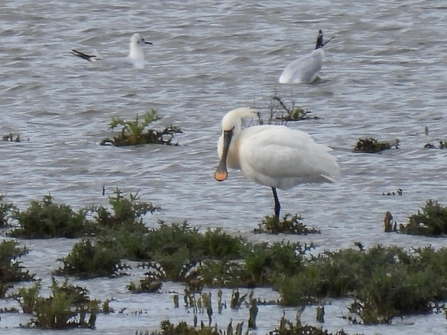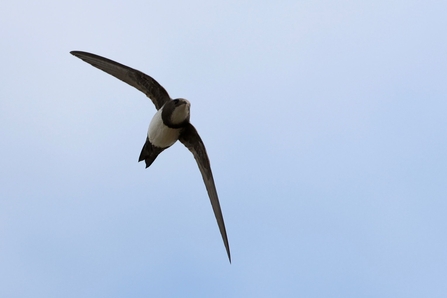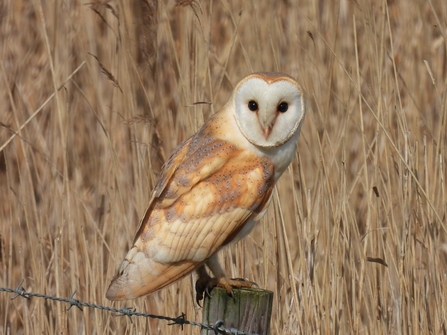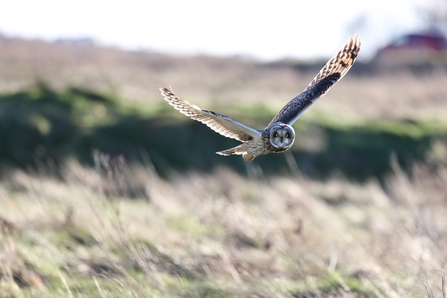The first avocet returned to Anderby Marsh on the 4th (a month earlier than last year). It is hoped that last year’s breeding birds (4 pairs) will return again this year. By the months end there 5 avocet present which was an encouraging sign. Other potential breeding species include 2-3 pairs of redshank and 2 pairs of lapwing. Migrant little ringed plovers were noted flying over the marsh on two dates. The majority of winter wildfowl had left the site by mid-month. A summer-plumaged spoonbill appeared on the marsh in late March and remained for two days.
Lincolnshire Coastal Country Park - March 2023

A spoonbill was present for two days in late March (Garry Wright)
Sightings at Huttoft Pit have been relatively sparse over the winter months, it is unclear what impact the 2022 drought may have had on the lagoon, after suffering approximately 90% water loss, this will undoubtedly have had an impact on the aquatic invertebrates. Despite the lack of water birds present, bearded tits remained on site all winter with double figures being noted on a near daily basis.
Major excitement was caused on the 20th with the finding of 2 Alpine swifts over Chapel Six Marshes. Miraculously both birds lingered in the area for six days proving very popular with visiting bird watchers. A few visitors had come as far as Loughborough to see the swifts. Alpine swifts are quite rare birds in the UK, this spring an unprecedented arrival of birds was noted, on a typical year 10-15 birds are noted, in a single week of April the total number of Alpine swifts exceeded 100 birds in the UK. The reasons for the unexpected arrival are unclear but could be linked to warm air flows and southerly winds over central Europe where this species occurs. This is the first ever double sighting of Alpine swift in Lincolnshire. The significance of the sighting was further highlighted by many visitors having never seen one before in the UK after bird watching for 30-40 years. I am sure this will be remembered by many for years to come. In excess of 200 people were thought to have visited Chapel over the six days!

Alpine swift – a rare visitor to the UK from central Europe, was present for six days and enjoyed by over 200 visitors (Garry Wright)
Red kite records continue to increase with seven records over the month. The first record in 2023 was on the 28th January, four weeks earlier than expected. This could be a reflection of increasing numbers on the Lincolnshire Wolds, possibly wandering birds looking for new territories, rather than passage migrants.
Returning spring migrants during March included little ringed plover (20th), sandwich tern (31st), swallow (31st), sand martin (21st), wheatear (31st), sedge warbler (31st) and willow warbler (30th). Many of these migrants have spent the winter in Africa. The favourable warm weather and southerly winds have aided in the migration of these species. In 2022, cold northerly winds throughout March delayed the arrival of many summer migrants by 2-3 weeks. The sedge warbler singing at Wolla Bank on 31st March is believed to be the earliest ever record in the Lincolnshire Coastal Country Park.
Impressive numbers of migrating finches were noted in late March predominately of siskin and chaffinch. These are birds that arrived in the UK during the autumn, to spend the winter, returning to breeding grounds on the continent, crossing into Europe via the shortest sea crossing (south-east coast). Rather than crossing large expanses of open sea being susceptible to exhaustion or unexpected inclement weather. Counts included: 55 siskin and 2078 chaffinch on 22nd, 2728 chaffinch on 23rd, 243 siskin and 1565 chaffinch on 24th and 103 siskin and 1429 chaffinch on 30th. At least 5 woodlark were recorded migrating through towards the end of the month. An impressive 7687 chaffinch flew south over the Lincolnshire Coastal Country Park throughout March in just over a week!
Short-eared owls continue to winter on the National Trust Sandilands nature reserve with at least 2 birds present, alongside regular barn owl. Meadow pipit and skylark were recorded singing throughout the reserve by mid-March.

Barn Owl – regular sightings at Anderby Marsh and National Trust Sandilands (Garry Wright)
An impressive 25 harbour porpoise sightings have been noted in 2023 so far mostly off Anderby Creek. This total far exceeds that of previous years and is thought to be in part due to increased observers in the area.
The first butterflies emerged late in March with small numbers of small tortoiseshell and peacock recorded.
Species to see in April
Cuckoo – The Lincolnshire Coastal Country Park is arguably the best area to see cuckoo in Lincolnshire! It is not unusual to see groups of 4-5 birds chasing each other around Anderby Marsh and Wolla Bank. Look out for them from mid-April onwards.
Green Hairstreak – Look out for this species on the England Coastal Path on warm days in late April. Elder and hawthorn trees are often favoured.
Large Red Damselfly – The first emerging damselfly of the year is often found in late April on warm days. This species can be seen anywhere and not necessarily near water.
Brown Hare – look out for boxing Hares on fine days
Sedge Warbler – a common species found in the reedbed. The density of birds in the Lincolnshire Coastal Country Park are among the highest in the county with an estimated 80 breeding pairs throughout! The sound of this species at dawn can be quite deafening.


